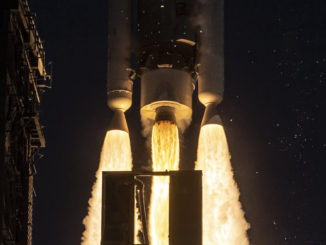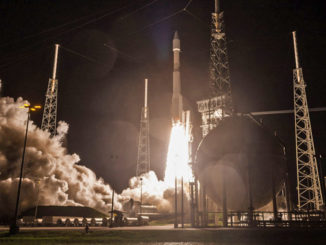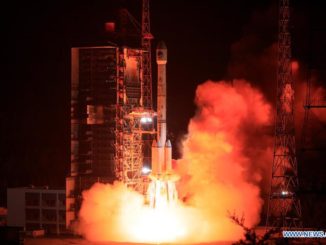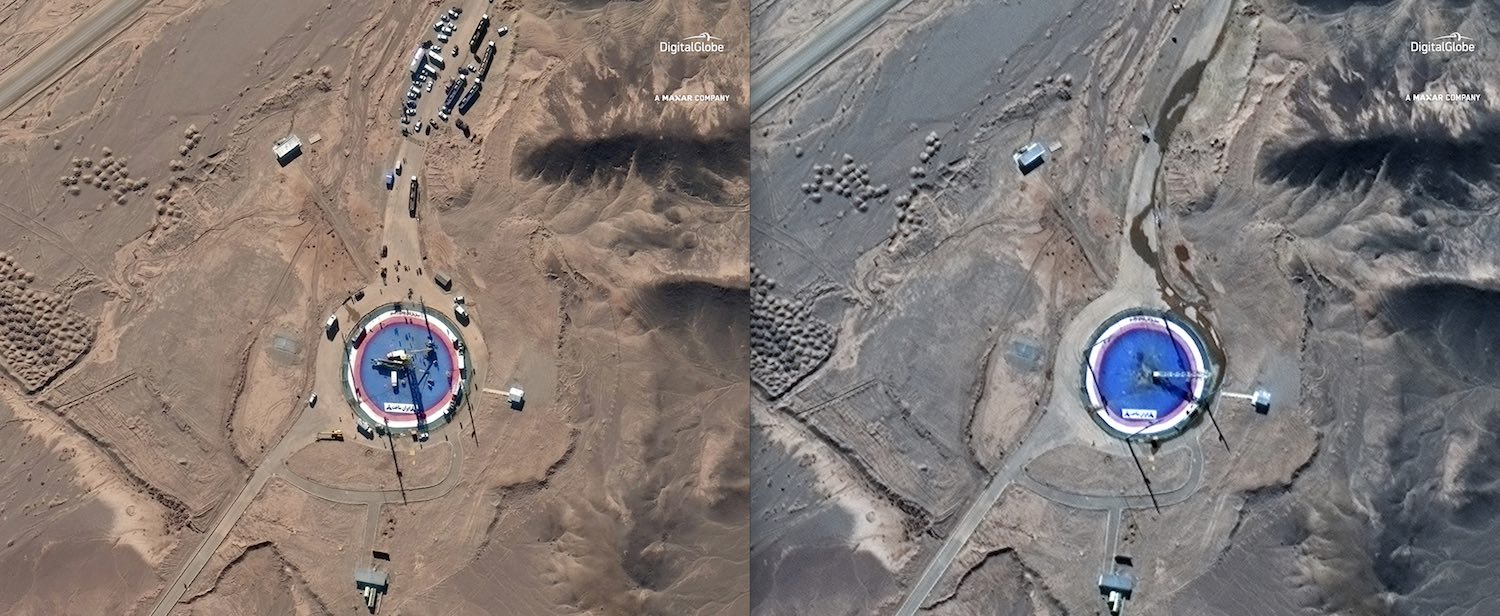
Iran’s second try in less than a month to send a satellite into orbit apparently failed shortly after liftoff from a remote desert launch pad under daily surveillance from a fleet of commercial imaging spacecraft, according to U.S. government officials and independent analysts.
Images of the launch pad in north-central Iran taken by orbiting satellites owned by U.S. companies suggest a rocket launch occurred last week, but the U.S. military’s catalog of space objects registered no new spacecraft in orbit. A satellite launch attempt was expected in recent weeks based on statements from Iran’s government and observations of increasing activity at the launch site.
One image taken by DigitalGlobe’s WorldView 3 Earth observation satellite Feb. 5 shows launch preparations at the site in full swing, with the shadow of a rocket visible at the spaceport in Iran’s Semnan’s province. Another pass by WorldView 3 over the launch base Feb. 6 produced an image showing burn scars at the circular launch pad, and a nearby stream of runoff, likely from post-launch wash-down activities.
A fleet of Earth-imaging satellites owned by Planet also monitored launch preparations at the Iranian spaceport. An image taken Jan. 21 shows a freshly-painted launch pad, and another from Planet on Feb. 6 shows scorch marks, like DigitalGlobe’s observations.
DigitalGlobe and Planet sell their imagery to the U.S. government, which uses the data to supplement pictures captured by government-owned National Reconnaissance Office spy satellites, whose capabilities and high-resolution images are classified.
The observations of a recent launch from Iranian space base were first reported by NPR, based on images first released by Planet.
Analysts believe the launch likely carried the Dousti microsatellite aboard a Safir booster, a smaller cousin of the Simorgh rocket that faltered during a launch Jan. 15 with the Payam-e Amirkabir imaging satellite. Dousti, which means “friendship” in Persian, was billed as a 114-pound (52-kilogram) remote sensing satellite in Iranian news reports ahead of the launch.
Iran’s information and communications minister, Mohammad Javad Azari Jahromi, said Feb. 4 that Dousti’s launch was expected soon, the last in a series of government announcements in recent weeks about the planned launch. None of the official statements indicated when the launch would occur.
Russia’s RIA Novosti news agency reported Iran’s deputy defense minister said that a launch last week delivered its payload into orbit, but the lack of any new satellites in the U.S. military’s public catalog of artificial space objects indicates the rocket failed before obtaining the speed required to enter orbit. Iranian officials acknowledged the Jan. 15 launch failure.
David Schmerler, a senior research associate at the Middlebury Institute of International Studies, believes the evidence of an Iranian launch observed by Planet and DigitalGlobe was a failed attempt to place Dousti into orbit. It used the same launch pad as previous Safir rockets that successfully placed Iranian satellites into orbit.
“Iranian media mentioned that the Dousti was ready to launch upon approval, and based on its reported weight, we suspected that it was going to be launched using their Safir SLV (Space Launch Vehicle),” Schmerler wrote in an email to Spaceflight Now. “Using Planet Labs imagery, we were able to see signatures that suggested a launch from the pad associated with the Safir. With those indicators and the recent satellite image showing the pad had been used, we think it was the Dousti.”
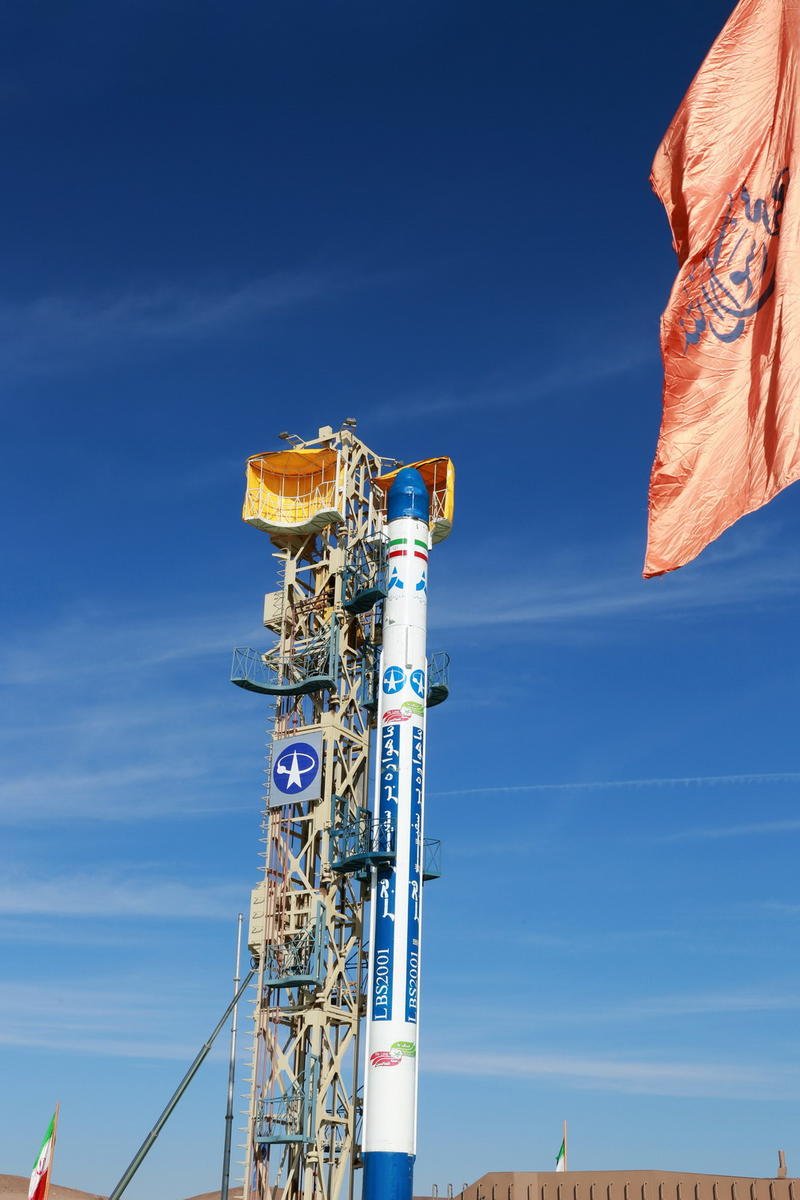
Analysts using commercial satellite imagery tracked preparations at two launch pads at the Semnan spaceport leading up to the Simorgh and Safir launch attempts Jan. 15 and last week.
“This was a special case for us because we had a lot of warning, starting in December, when the Iranians started talking about the launches,” said Jeffrey Lewis, an arms control expert at the Middlebury Institute of International Studies at Monterey, California. “Planet was willing to task SkySats, so starting I think on the second of January, we got daily images. Some days it was cloudy, but we got a picture of the launch site basically every day. So we got to watch the preparations in a level of detail we hadn’t seen before.”
The U.S. State Department acknowledged last week’s Safir launch attempt in a statement accusing Iran of using the satellite program to advance technologies for a long-range missile.
“In defiance of the international community, the Iranian regime continues to develop and test ballistic missiles, including a reported second failed space launch in less than a month,” said Robert Palladino, a deputy State Department spokesperson. “Space launch vehicles use technologies that are virtually identical and interchangeable with those used in ballistic missiles, including in Intercontinental Ballistic Missiles (ICBMs). This attempted launch furthers Iran’s ability to eventually build such a weapon that threatens our allies.”
In an interview last month with Spaceflight Now, Lewis said rockets like the three-stage Simorgh and two-stage Safir would not make very effective ballistic missiles, although all rockets “have an inherent dual-use capability.”
“The Safir and the Simorgh are basically the same technological base as North Korea’s space launchers,” Lewis said. “And what we saw with the North Koreans is when they got serious about building an ICBM, they didn’t use those underlying technologies. They built a new engine. They used a better fuel, so that they could make an ICBM that was powerful but mobile. While I understand that opening a physics textbook has dual uses, this is not the particular textbook I would open for an ICBM program.”
“You could militarize this capability, it’s just that it would be kind of jury-rigged,” Lewis said. “You’d have to assemble the rockets long in advance, and you’d have to have the fuel on site, so they would be very easy to identify, and they would be very vulnerable.”
Four successful Safir launches have placed Iranian satellites in orbit since 2009, when Iran inaugurated its independent orbital launch capability. The larger Simorgh booster is based on a newer design, but has not yet successfully placed a payload into orbit.
Schmerler wrote in a tweet that the Iranian government’s continued use of the Safir, which first flew more than a decade ago, suggests Iran is in no rush to develop an ICBM.
“If anything, the fact they used this older system actually reinforces Iran’s interest in a separate space program,” Schmerler said.
Army Lt. Gen. Robert Ashley, director of the Defense Intelligence Agency, told the Senate Armed Service Committee last March that Iran is “developing more powerful space launch vehicles, boosters that would be capable of ICBM ranges if configured for that purpose.”
But no such long-range weapons are operational in Iran, Ashley said.
“What they have in their inventory are short-range ballistic and medium-range ballistic missiles,” he said. “They do have a space launch vehicle, the Simorgh, which they’ve tested a couple of times. The reliability (of the Simorgh) is not there, so today, if you were to ask me does Iran have an ICBM capability, they do not. Is that aspirational? Yes. Could they take that space launch vehicle and start working it toward an ICBM capability? They could, but that is many years out.”
Email the author.
Follow Stephen Clark on Twitter: @StephenClark1.

